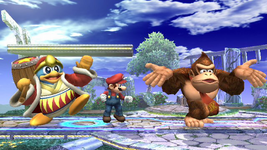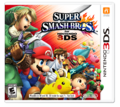Super Smash Bros. 4: Difference between revisions
Master Zach (talk | contribs) No edit summary |
(→Trivia) |
||
| Line 291: | Line 291: | ||
*''Super Smash Bros. 4'' introduces the [[Mii Fighter]]s, making it the first game in the series to have normally playable characters representing the ''Super Smash Bros.'' universe. | *''Super Smash Bros. 4'' introduces the [[Mii Fighter]]s, making it the first game in the series to have normally playable characters representing the ''Super Smash Bros.'' universe. | ||
*''Super Smash Bros. 4'' is the only game in the series to cut all playable characters within a universe, cutting both the [[Ice Climbers]] and [[Snake]], from ''Ice Climber'' and ''Metal Gear'', respectively. | *''Super Smash Bros. 4'' is the only game in the series to cut all playable characters within a universe, cutting both the [[Ice Climbers]] and [[Snake]], from ''Ice Climber'' and ''Metal Gear'', respectively. | ||
*''Super Smash Bros. 4'' introduces 10 new universes with playable characters, tied with [[Super Smash Bros.|the first game]] for the most of any entry in the ''[[Super Smash Bros. (series)|Super Smash Bros.]]'' series. | *''Super Smash Bros. 4'' introduces 10 new universes with playable characters, tied with [[Super Smash Bros.|the first game]] and [[Ultimate]] for the most of any entry in the ''[[Super Smash Bros. (series)|Super Smash Bros.]]'' series. | ||
*''Super Smash Bros. 4'' marks the first time in the series where long-running veterans [[Luigi]] and [[Marth]] are starter characters. [[Jigglypuff]] and [[Ganondorf]] also have this distinction, though only in the Wii U version. | *''Super Smash Bros. 4'' marks the first time in the series where long-running veterans [[Luigi]] and [[Marth]] are starter characters. [[Jigglypuff]] and [[Ganondorf]] also have this distinction, though only in the Wii U version. | ||
*''Super Smash Bros. 4'' is the only game in the series to | *''Super Smash Bros. 4'' is the only game in the series to not feature a form of bonus game in the 1P Game/Classic Mode. | ||
*''Super Smash Bros. 4'' marks the first ever playable appearance for [[Wii Fit Trainer]], [[Palutena]], and the [[Duck Hunt]] dog. | *''Super Smash Bros. 4'' marks the first ever playable appearance for [[Wii Fit Trainer]], [[Palutena]], and the [[Duck Hunt]] dog. | ||
*''Super Smash Bros. 4'' is the second collaboration between [[Bandai Namco]], [[Capcom]], and [[Sega]], the first being ''{{s|wikipedia|Project X Zone}}'' and the third being its sequel ''{{s|wikipedia|Project X Zone 2}}''. One of ''Project X Zone'''s co-developers, [[Monolith Soft]], was involved in ''Brawl'' and ''SSB4''. | *''Super Smash Bros. 4'' is the second collaboration between [[Bandai Namco]], [[Capcom]], and [[Sega]], the first being ''{{s|wikipedia|Project X Zone}}'' and the third being its sequel ''{{s|wikipedia|Project X Zone 2}}''. One of ''Project X Zone'''s co-developers, [[Monolith Soft]], was involved in ''Brawl'' and ''SSB4''. | ||
Revision as of 06:59, November 24, 2021
| “ | SETTLE IT IN SMASH! | ” |
| —North American commercial | ||
| Super Smash Bros. 4 (unofficial title) | |
|---|---|
 Collective logo for the game. | |
| Developer(s) | Bandai Namco Sora Ltd. |
| Publisher(s) | Nintendo |
| Designer(s) | Masahiro Sakurai |
| Engine | Havok |
| Released | Nintendo 3DS September 13, 2014 October 2, 2014 October 3, 2014 October 4, 2014 July 24, 2015 September 10, 2015 Wii U |
| Genre(s) | Fighting Platforming |
| Mode(s) | Single player, Multiplayer, Online multiplayer |
| Ratings | CERO: A ESRB: E10+[1] OFLC: PG[2] PEGI: 12+ |
| Platform(s) | Wii U, Nintendo 3DS |
Super Smash Bros. 4 (also referred to by shorthands such as Smash 4, SSB4, for, or more informally Sm4sh, and officially as Super Smash Bros. for Nintendo 3DS / Wii U) is a term used to collectively refer to Super Smash Bros. for Nintendo 3DS and Super Smash Bros. for Wii U, two games in the Super Smash Bros. series created by Bandai Namco[3] and Sora Ltd. In an interview with Kotaku, Masahiro Sakurai has stated he considers the 3DS version the fourth installment and the Wii U version the fifth installment. The games feature mostly identical gameplay, but with several differences in other areas. The 3DS version is the first game of the series to be released on a handheld.
The 3DS version launched in Japan on September 13th, 2014, in most other parts of the world on October 3rd, 2014. It was released in stores one day earlier in Germany on October 2nd, 2014 to avoid coinciding with German Unity Day, and was released one day later in Australia on October 4th, 2014 because of time zone differences. Hong Kong and Taiwan received a release of the game over ten months later, on July 24th, 2015, while South Korea got its release on September 10th, 2015, nearly a full year after the game's initial launch in Japan. The Wii U version was released in North America on November 21st, 2014, and was released on November 28th, 2014 in Europe, November 29th, 2014 in Australia, and on December 6th, 2014 in Japan.
Both versions have received positive reviews; critics applauded the fine-tuning of existing gameplay elements but criticized some issues with online play. The 3DS version sold over 9.63 million copies worldwide as of September 30, 2021, and the Wii U version sold over 5.38 million copies as of September 30, 2020.
Fighters



Both games feature identical character rosters. The roster contains a total of 58 characters, 34 of which return from Brawl, three of which return after being cut in the transition from Melee to Brawl (Dr. Mario, Mewtwo, and Roy), and 21 of which are new to the series. Of these 58, 39 are starter characters in both versions and eight are unlockable characters in both versions, while four characters are unlockable in the 3DS version but starters in the Wii U version. Additionally, seven characters appear as downloadable content. A further twelve "characters" exist as alternate costumes for other preexisting characters: Alph as a palette swap of Olimar; each of the seven Koopalings as palette swaps of Bowser Jr., and alternate genders for Villager, Wii Fit Trainer, Robin, and Corrin.
Five characters do not return from Brawl: Pokémon's Squirtle and Ivysaur (alongside the Pokémon Trainer himself), Star Fox's Wolf, Metal Gear's Snake, and two-time veteran, Ice Climber's Ice Climbers. Lucas initially did not return in the base roster, but he would later return through DLC.
As for the new characters for already represented franchises, two newcomers come from the Mario universe being Bowser Jr. and Rosalina, Greninja for the Pokémon universe, Kid Icarus introduces Palutena and Dark Pit and finally Fire Emblem introduces Lucina, Robin and, as DLC, Corrin.
New characters slots are given to Punch-Out's very own Little Mac who first appeared as an Assist Trophy from Brawl, the Wii Fit Trainer from the Wii Fit series, the Villager's inclusion marks Animal Crossing's first playable character, Shulk, who introduced the Xenoblade Chronicles series and finally Duck Hunt consisting of a dog and duck from their series of the same name.
Sonic the Hedgehog returns as a third-party character, now joined by Mega Man and Pac-Man, as well as Ryu, Cloud Strife, and Bayonetta through DLC.
| Veterans (37) | |||||||||||||||
|---|---|---|---|---|---|---|---|---|---|---|---|---|---|---|---|
 Mario |
 Luigi |
 Peach |
 Bowser |
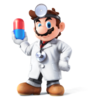 Dr. Mario |
 Yoshi |
 Donkey Kong |
 Diddy Kong | ||||||||
 Link |
 Zelda |
 Sheik |
 Ganondorf |
 Toon Link |
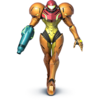 Samus |
 Zero Suit Samus |
 Kirby | ||||||||
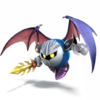 Meta Knight |
 King Dedede |
 Fox |
 Falco |
 Pikachu |
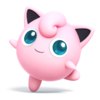 Jigglypuff |
 Mewtwo (DLC) |
 Charizard | ||||||||
 Lucario |
 Captain Falcon |
 Ness |
 Lucas (DLC) |
 Marth |
 Roy (DLC) |
 Ike |
 Mr. Game & Watch | ||||||||
 Pit |
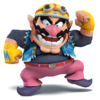 Wario |
 Olimar |
 R.O.B. |
 Sonic |
|||||||||||
| Newcomers (21) | |||||||||||||||
 Rosalina & Luma |
 Bowser Jr. |
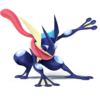 Greninja |
 Robin |
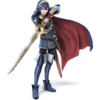 Lucina |
 Corrin (DLC) |
 Palutena |
 Dark Pit | ||||||||
 Villager |
 Wii Fit Trainer |
 Little Mac |
 Shulk |
 Duck Hunt |
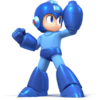 Mega Man |
 Pac-Man |
 Ryu (DLC) | ||||||||
 Cloud (DLC) |
 Bayonetta (DLC) |
 Mii Brawler |
 Mii Swordfighter |
 Mii Gunner |
|||||||||||
Bold denotes unlockable characters in both versions.
Bolded italics denote unlockable characters in the 3DS version only.
Stages


The two games feature considerably different stage selections, which is one of the primary differences between the two games. The 3DS version features a total of 42 stages with seven unlockable stages and eight DLC stages, 30 of which are new and 12 of which are familiar. The Wii U version features a total of 55 stages with six unlockable stages and nine DLC stages, consisting of 34 new stages and 21 familiar ones. Only 13 stages are shared between the two versions, six of which are DLC.
In general, the 3DS version's new stages are based more on handheld console games, while the Wii U version's new stages are based more on home console games, though there are several exceptions to this in both games.
Past Stages in both games are now known as "Familiar Stages." Only three Familiar Stages are shared between the two games, all of which are DLC.
The Wii U version also has an option to create custom stages with the Stage Builder.
3DS version
Bold denotes unlockable stages.
Wii U version
Bold denotes unlockable stages.
Modes
Multiplayer
- VS Mode
- 8-Player Smash (Wii U exclusive): In this mode, up to eight players can play in Smash battles, compared to the standard limit of four. Due to system resources, some stages have their behavior modified while in this mode, while other stages are not available at all.
- Special Smash (Wii U exclusive): The successor to Special Brawl, players in this mode can create custom battles by changing a variety of options, such as making all the fighters metal. Up to four players can play in this mode. This mode does not affect records and stats.
- Smash Run (3DS exclusive): In this mode, up to four players have five minutes to traverse a large dungeon-like environment, collecting various power-ups and facing enemies from multiple games. After the time limit, the players fight in a battle utilizing their boosted powers, and can then do subsequent matches with those power-ups. Sakurai mentioned in the April 2014 Nintendo Direct video that it took inspiration from Kirby Air Ride's City Trial mode, which has a similar premise.
- Players are also able to have items set to their characters via character customization.
- Smash Tour (Wii U exclusive): Players take control of Miis moving along a game board, collecting characters and power-ups to win the final match, with each fighter obtained acting as one stock.
- Tournament Mode (Wii U exclusive): A competitive elimination mode returning from Melee and Brawl, which was released as a downloadable online feature.
Single Player
- Classic Mode
- All-Star Mode
- Home-Run Contest
- Trophy Rush
- Target Blast
- Multi-Man Mode
- Training Mode
- StreetSmash (3DS exclusive)
- Event Mode (Wii U exclusive)
- Special Orders (Wii U exclusive)
- Trophy Box (Wii U exclusive)
Development
SSB4 was announced in passing at E3 2011. The game's development was not slated to begin until sometime after October 2011, after the completion of Sakurai's other project, Kid Icarus: Uprising.[4] He had stated, in response to a fan asking him about whether a "child Link" would be in the game, that he had not at the time decided on which characters would appear. However, he had also said that he "can't say that it's entirely out of the realm of possibility that some Capcom character could appear in the next Smash Bros."[5] Indeed, Capcom's Mega Man was ultimately confirmed as playable, and Ryu was made available as DLC. The paired versions of the game were officially revealed at E3 2013 in the form of a trailer on June 11, 2013, with a projected release in 2014.
Development of the game began in early 2012[6], but it went unmentioned during E3 2012, something which many fans were disappointed about despite the known extremely early state of the game; the "first step of the process" was taken shortly after in mid-June. Sakurai expressed disappointment that fans would be waiting for longer than expected for the game to be released due to the earliness of the initial announcement.[7] Shortly afterward, it was revealed during a Nintendo Direct that Namco Bandai (as Bandai Namco was previously named) was the primary developer alongside Sora Ltd., and had already completed a working prototype.[3]
On July 2nd, 2012, Sakurai posted a whiteboard drawing on Twitter which was drawn by the game's staff. It depicts Donkey Kong, Fox, a Heart Container, Kirby, Link, Luigi, Mario, Marth, Meta Knight, Mr. Game & Watch, a Mr. Saturn, Pikachu, a Pikmin, Pit, Sandbag, Wario, and Zero Suit Samus; some argue that the curved lines in the background form the shape of Master Hand. The sketch also has what appears to be large block letters hidden below the visible area. While the post came with no explicit confirmation of any of these characters or elements as reappearing, it did show that they were in some sense acknowledged by the staff; everything depicted would, in fact, appear in the final game. The image itself was later removed from the original Twitter post.[8]
Sakurai had remarked that one feature of the 3DS Smash Bros. title would be that players can improve their character through battles and rewards, then transfer them to the Wii U Smash title to play against friends; such a function was ultimately made possible through character customization. He also said the 3DS title was intended to offer a new experience for veteran Smash Bros. fans, and that neither the 3DS game nor the Wii U game would simply be sequels like Melee and Brawl were, and that they would do more than just add characters and stages. It had also been revealed that they were looking towards co-operative play for the Wii U title. Official Nintendo Magazine said, "there is merit in having skilled and unskilled players play together, so one emphasis will be on elements of players helping one-another." They also stated that the graphics would be significantly stepped up, as the Wii U can handle high-quality graphics, dynamic effects and smooth character movements in HD at 60 frames per second.[9] Sakurai was also quoted as claiming that the new game was unlikely to emphasize new playable characters, focusing instead on gameplay balance and distinctiveness of its characters. [10] Indeed, SSB4 initially introduced fewer newcomers than Brawl did.
Shortly after the initial E3 2013 trailers, Sakurai said there would be a single-player story mode included in the new Smash Bros.[11], but that it would be different from Brawl's Subspace Emissary in that there would be no cutscenes, since he did not want them to be uploaded to the Internet. However, he would later recant this and announce that he decided to cut any story mode altogether [12].
Sakurai had stated that there were no plans to implement downloadable content or touch screen controls of any variety. However, he also said that once the game was released DLC was something they would take into consideration. [13] Downloadable content was eventually implemented through several additional fighters, stages, and costumes for Mii Fighters.
Changes from Brawl
Gameplay
- In an attempt to appeal to both casual and hardcore gamers, Smash 4’s gameplay strikes a balance between Melee’s faster, more technical gameplay and Brawl’s slower, more relaxed gameplay.
- This is most easily apparent in Smash 4’s game speed: most veterans from Brawl have faster dashing, falling, and air speeds, and additionally traction and gravity stats were also generally increased, though the game speed is still noticeably slower and floatier than Melee.
- The differences in size across the cast are now more pronounced, with Bowser now standing much taller than Mario, compared to being only slightly taller in previous games. Larger characters like Donkey Kong are thus easier to hit but benefit from longer reach, while smaller characters like Kirby are harder to hit while hindered by shorter range.
- The differences in range across the cast have been overall toned down, with melee-oriented characters like Diddy Kong having more elastic limbs, while sword-wielders have shorter range either through the improvements in range to the rest of the cast (e.g., Marth) or direct nerfs to their range (eg. Meta Knight).
- Random tripping has been removed, making extended dash-dancing a viable movement option.
- Pivoting, a movement technique previously possible in Smash 64 and Melee has been reintroduced, generating more flexible mobility than in Brawl.
- Mid-match character transformations have been removed. Sheik, Zelda, Zero Suit Samus, Samus, are all now completely separate characters, while Charizard returns as a standalone fighter in place of the Pokémon Trainer. These changes are partially due to hardware limitations on the 3DS and Sakurai’s own wish for both versions of the game to feature the same roster.
- Edge-hogging having been removed entirely, as attempting to grab a ledge that someone else has already grabbed onto will now gently remove them from the ledge and "steal" it, a mechanic known as "ledge trumping".
- Ledge trumping itself can be used as an edgeguard, as it leaves the recovering opponent vulnerable.
- No intangibility at all will be granted if a character grabs the ledge twice without touching the ground or being hit, making them more open to edgeguarding.
- The length of intangibility given by grabbing the ledge is now affected by air time and current damage, and does not carry over if the character drops from the ledge.
- The difference between fast and slow edge options based on current damage has been removed.
- Characters cannot grab the ledge after going through hitstun for at least 55 frames.
- The general recoveries of the cast have also been improved, with many of them traveling farther and having better protection while benefiting from the faster air speeds and new ledge mechanics; these changes weren't entirely consistent across the cast, however, and recoveries are overall more polarized than in previous games.
- Meteor canceling has been removed, making meteor smashes functionally equivalent to spikes and thus much deadlier edge-guarding moves.
- To compensate, several meteor smashes are now weaker, with a few requiring more specific hitboxes (such as Ike's down aerial).
- Characters that are meteor smashed onto a floor will now bounce back up at a fraction of their current knockback speed.
- All characters are granted 70 frames of invulnerability to all grabs and command grabs after being released from a grab or thrown, making it impossible to perform chain grabs.
- Stale-move negation has been weakened, making it harder for characters to abuse the above mechanic which allows for moves to combo for longer; at the same time, characters do not have to worry about preserving their KO moves as much as they did in Brawl, though still more than in Melee.
- Hitstun canceling, a controversial mechanic introduced in Brawl that allowed characters to escape combos with ease, has been toned down. Characters can now air dodge or use an aerial attack to cancel hitstun after 40 or 45 frames respectively, compared to Brawl’s 13/25 frames, with the window being pushed back when a character sustains 69 or more frames of hitstun, due to a limit being set on how fast a fighter's current launch speed can be when attempting to cancel hitstun.
- As a result, true combos at low and mid percents are much more prevalent. However, with the increased knockback growth on many throws, moderate falling speeds, gravity increasing vertical knockback, the continued lack of advanced techniques such as wavedashing and L-cancelling, and the retained ability to cancel hitstun, true combos in Smash 4 are generally shorter and less varied compared to the ones in Melee and Smash 64, especially at high percents.
- Additionally, many of the faster, more combo-oriented fighters, such as Sheik, Fox, Meta Knight, and Diddy Kong have had their damage outputs reduced, likely to compensate for their improved combo abilities or to balance them out with the slow, heavy characters.
- The changes to hitstun prevents characters from immediately performing moves to slow their momentum, reducing their ability to survive powerful attacks.
- Directional influence works differently. The angle deviation is less significant than in previous games, while a submechanic known as launch speed influence (LSI for short) has been introduced, which increases characters' launch speed the more the control stick is held upward, and decreases it the more it is held downward. As of update 1.0.4, moves with too vertical angles are only affected by DI, not LSI. These changes make it harder to carry out horizontal combos, especially at higher percents since opponents will often be sent too far for followups.
- In turn, this indirectly benefits characters who possess vertical-launching moves, notably Mario, Meta Knight, Zero Suit Samus, and Ryu, as it is now comparatively easier to combo and KO with attacks that deal vertical knockback.
- The effects of smash directional influence have been drastically weakened, which is most easily visible with multi-hit attacks, making it much harder to escape them than in earlier games.
- Movement speed when carrying heavy items has been increased among the entire cast, but Donkey Kong remains as the only character who can jump and fall with them.
- A new mechanic, unofficially known as "rage", has been implemented. Characters receive a steady increase to the knockback (and therefore hitstun) of their attacks as their damage rises starting at 35%, with the effect capping out at 150%. Rage becomes more visible when a character reaches 100%, as they begin to flash red and emit steam.
- Shields now take 19% more damage from attacks, rather than 30% less. As of update 1.1.1, shield stun has been significantly increased, making out of shield options less reliable; thus, shields are much more fragile than in Brawl.
- When having their shields broken, fighters are now intangible until they hit the ground and enter their stunned animation. This slightly narrows the window in which a fighter can be attacked when their shield is broken, as well as making it impossible to use windboxes to push opponents offstage while falling to the ground to be stunned. However, it also prevents players from saving teammates who are tumbling to their death due to being forced over the ledge when their shield broke.
- When a fighter's shield is hit when they are right on the ledge, they are no longer guaranteed to be pushed off the ledge and put into tumble, and instead the attack must be sufficiently strong enough to push the shielding player with enough force to trigger a ledge slip.
- Attempting to land with an air dodge now results in high landing lag (21 frames), but air dodges in general are faster, having decreased intangibility durations, but also lower ending lag (roughly 5 frames, down from 10 to 30 in Brawl), making air dodges safer for aerial combat but riskier when done close to the ground.
- Sidesteps and rolls have slightly less ending lag but offer fewer intangibility frames, which makes rolls overall safer for quick repositioning.
- Careening has been removed, meaning that fighters experiencing knockback can no longer hit other victims during hitstun.
- Both Star and Screen KOs do not always occur when a character is KO'd over the top blast line, now being chosen at random along with the normal blast KO.
- They no longer occur near the end of a timed match (unless characters are launched to the upper blast line when End of Day is active, the only known exception to this) or Sudden Death; being instead replaced by regular blast KOs. In addition, they also will not occur when a character is launched at a fast enough speed.
Game modes
- In a similar appeal to both casual and hardcore gamers, there are now two distinct type of With Anyone Wi-Fi modes; one called For Fun which is similar to the previous game's casual-styled Basic Brawl, and one called For Glory, a mode explicitly catered to competitive-styled play. Additionally, every stage now has an "Ω Form," where the stage's layout is altered into that of Final Destination. These forms cannot be played on in the For Fun mode, while they are the only forms available in the For Glory mode.
- All stages now have a Ω form, which is a Final Destination-like layout consisting of a single flat platform with all stage hazards removed.
- In the More Rules section, there's an option to setting how many points a player loses upon self-destructing in a Timed match.
- "Multi-Man Brawl" is now referred to as "Multi-Man Smash". Additionally, the Fighting Alloy Team have been replaced by the Fighting Mii Team, consisting on Mii Fighters wearing black jumpsuits with a white "M" letter printed on its anterior and two white "i" letters around their limbs.
- An additional game mode has been added known as Rival Smash, replacing 15-Minute Smash from Brawl. It involves the player competing for KOs against a CPU-controlled copy of their character.
- Tips has been added, which appear on multiple loading screens and is their own specialized menu in the Vault.
- Classic Mode has been reworked depending on the version:
- All fighters now have a trophy based on one of their alternate costumes (with the exception of Bowser Jr.), similar to the "Smash" fighter trophies from Melee, which can be obtained by
 clearing All-Star mode (replacing the Final Smash trophies from Brawl), or
clearing All-Star mode (replacing the Final Smash trophies from Brawl), or  purchased at the Trophy Shop for 1000G after clearing Classic mode; unlike them, each fighter have only one "(Alt.)" trophy as opposed to two. The Alph and the Koopalings trophies can also be obtained at the Trophy Shop after clearing Classic mode. In the Wii U version, clearing the All-Star mode instead gives the Final Smash trophies like in Brawl, making all fighters once again having three trophies in total (not counting Alph and the Koopalings).
purchased at the Trophy Shop for 1000G after clearing Classic mode; unlike them, each fighter have only one "(Alt.)" trophy as opposed to two. The Alph and the Koopalings trophies can also be obtained at the Trophy Shop after clearing Classic mode. In the Wii U version, clearing the All-Star mode instead gives the Final Smash trophies like in Brawl, making all fighters once again having three trophies in total (not counting Alph and the Koopalings).
Aesthetic and sound changes
- In general, the game is much more stylized and visually intense than previous entries, with the colors being bolder and brighter, sound effects being more cartoonish (though generally quieter) and many elements having been redone to stand out more.
- The characters' design styles are more distinct from each other and more in-line with their home series, in contrast to Brawl which gave the characters a more unified realistic look. For example, characters from cartoony franchises such as the Mario and Kirby series are much closer to their native styles, while those from more realistic-looking franchises such as The Legend of Zelda (with the exception of Toon Link) and Metroid series maintain more realistic appearances.
- Some characters will always stand to face the screen regardless of which direction they turn, with the intent of having them face the screen more often.
- Damage percentage numbers now rise through yellow shades before turning red. In the Wii U version, the numbers are also displayed with a metallic gradient.
- Several visual effects are significantly bolder and brighter:
- Attacks' visual effects (such as motion blurs) are in general more pronounced, with bright saturated blurs replacing the previous game's subtle ones.
- Most spherical, energy-based projectiles (such as Charge Shot, Aura Sphere and Shadow Ball) now appear less smoothly designed and significantly spikier, alongside being more visually intense.
- Many attacks have bright motion trails, making their range more obvious.
- Smoke trails of struck characters are now thick trails of light, which become more prominent with higher amounts of knockback and are colored according to which player would be credited with a potential KO. Should the KO occur, the attacker will flash with an aura of their own color.
- In the Wii U version, the attacker's damage meter will also show a brief burst of flame when a KO occurs.
- Screen KOs have a new animation in which a fighter flies towards the screen and hits it face-first, staying in place briefly before sliding down. The overall animation has been lengthened to last a few frames longer than the Star KO animation.
- The victim no longer uses their light knockback voice clip when colliding with the screen, being replaced by a sound effect.
- The echo effect used for Final Smashes, Star KOs and the announcer, Master Hand and Crazy Hand's voice clips are smoother (with the exception of male Wii Fit Trainer when using Wii Fit), in contrast to Brawl where they had a heavy reverberating effect.
- A new visual effect is introduced, referred to as Deadly Blow by the game; hits that deal enough knockback to KO the character before they can act produce a red-and-black lightning effect during hitlag if they are close enough to the blast line. However, the effect is not always consistent, as it does not factor in DI or other obstructions, and does not always appear at an attack's minimum KO threshold. Attacks that cause freezing never produce the visual effect, instead, the screen briefly flashes white. Meteor smashes do not produce it until high percentages.
- Certain items such as the Bumper and Home-Run Bat have been given new, more striking designs. For example, the Home-Run Bat is more ornate and is now colored to match the new high-knockback lightning effect.
- A successful meteor smash that deals high knockback will play a distinct sound effect.
- Characters now have team colored outlines in Team Battles, and can select a color normally.
- Revival platforms now have a section that changes color based on the time remaining before the platform disappears. This section starts out yellow before fading between orange and then turning red before disappearing.
- Characters with over 100% of damage now flash red and emit steam, as part of the new rage game mechanic. The effect intensifies as their damage raises.
- In the 3DS version, players can tap on a character's icon on the bottom screen to place a marker on that character on the top screen, in order to more easily follow their movements.
- Magic and PK attacks no longer have electrical properties and produce sparkle sounds if they hit.
- Victory scenes seem to be a cross between all of the previous three games. Like in Smash 64, the screen has different animations that transition to the scene, instead of just cutting to it, while only the winner is shown in the main area like in Melee, with the others applauding in small windows on the screen on the Wii U version. However, instead of a featureless black screen, the winner's area is an environment similar to that in Brawl’s victory screen. Additionally, after the winner has been announced and the victory theme has finished playing, a remix of the character select music from Smash 64 will play (with the exception of Cloud, as his victory theme loops rather than finishing).
- The Stock Icons for Stock Matches are now akin to those in Melee, in which they appeared as the character's head, as opposed to Brawl, where they were merely small circles colored depending on the player. Additionally, the stock icons are placed below the HUD that contains the character's damage percentage rather than on it.
- Assist trophies and Poké Ball Pokémon now come with a marker above them, in order to indicate which player summoned them.
- Additionally, certain items come with white triangular markers above them to make them more noticeable, like in SSB64.
- Some of the more realistic sound effects from Brawl have been eschewed in favor of sound effects which are inspired by the characters' home franchises, such as the one that plays when Kirby uses Inhale.
- Like in the previous games, each character has a voice clip for whenever they take a fair amount of knockback. Though now, it plays right as they receive the blow, like in the original Super Smash Bros. and Melee, and not during the knockback itself, like in Brawl. In SSB4, damage noises are no longer based purely on the amount of knockback taken, unlike in SSB64 and Melee, where characters had damage noises for medium damage and hard damage specifically. This means that certain attacks and items that repeatedly launch the character can make them repeat the voice clips constantly, such as the Drill.
- Most flash/tint effects (such as flashing white while invincible) do not display while the game is paused.
- On the Wii U version, most stages have constant subtle ambient noise in the background, such as wind (Onett and Mushroom Kingdom U) or animal sounds (Kongo Jungle 64). This is a new addition to most returning stages.
- Many characters are much more expressive than in Brawl; for example, Wario now scowls when performing an attack, and in the Wii U version, Wario's mustache and eyebrows now stretch and grow to fit the situation.
- Each character's expressions are different between versions, mainly due to processor limitations on the 3DS version. An example can be seen during victory scenes: for example, if Marth were to win a match, he would keep a serious face on for 3DS, while he would slightly smile and look at the screen on for Wii U.
Item changes
- Fighters under the effects of a Timer will be shown with a swirling graphical effect.
- Pressing the attack button on a shooting item with no ammunition now has the fighter throw it instead of firing an empty shot.
Console differences
The Wii U and 3DS versions of the game were shown to have distinct art styles from one another in that the 3DS version uses flatter shading and optional black outlines to make characters easier to see at a distance, a graphical style reminiscent of other 3DS games such as Fire Emblem Awakening and Pokémon X & Y. These outlines are customizable as Sakurai stated players can change the size of the outlines or get rid of them completely. As stated before, many of the stages are version specific, with the 3DS version having more stages based on handheld console games, and the Wii U having more stages based on home console games.[14] There is no cross-platform gameplay between the Wii U and 3DS versions due to the exclusive stages to each version[15]; however, one can create customized fighters in the 3DS version using the character customization feature and send them to the Wii U version. In addition to this, by connecting the two games (or using a special downloadable application), the 3DS can be used as a controller on the Wii U version. However, this doesn't apply vice-versa, as none of the Wii U's peripherals can act as a controller on 3DS hardware.
In the 3DS version, there is up to the usual amount of fighters on one stage, with four. The Wii U version features up to eight players at once, though this is only available on a limited selection of the stages.
Trophies are different between the two versions, with the trophies in the 3DS version being mainly from handheld games, while the trophies in the Wii U being primarily from console games.[16]
When it comes to music, each stage on the 3DS version has only two music tracks available, as was the case in Melee. On the other hand, the Wii U version sees the return of Brawl’s My Music option, with a large selection of tracks available for each stage.
Reception
The 3DS version received positive reviews, with a current rating of 85/100 on Metacritic[17] and 86.1% on GameRankings[18]. The game has been praised for its large and diverse character roster, its improvements to game mechanics, and its variety of multiplayer options. Some criticisms include a lack of single player modes and issues concerning the 3DS hardware, such as the size of characters on the smaller screen when zoomed out and latency issues during both local and online multiplayer. There were also reports of players damaging their 3DS Circle Pads while playing the game excessively, and to an extent, the circle pad can easily fall off. The 3DS version sold over a million copies in its first weekend on sale in Japan and had sold more than 3.22 million copies worldwide as of October 2014. The 3DS version was nominated for both Best Fighting Game and Best Handheld/Mobile Game at The Game Awards 2014, but lost to the Wii U version and Blizzard Entertainment's Hearthstone: Heroes of Warcraft, respectively.
The Wii U version received critical acclaim, with a Metacritic score of 92/100[19] and a GameRankings score of 92.39%[20], being among the highest rated games of 2014, is also awarded the Metacritic's Game of the Year and the second-highest rated game of the series after Brawl. The 2014 Video Game Awards even awarded the Wii U version with the "Best Fighting Game" award. The game was lauded for improving everything the 3DS version offered and significantly improving the online experience.
Super Smash Bros. 4 won "favorite video game" at the 2016 People's Choice Awards. As of February 2016, the Wii U version is the 5th best selling Wii U game, whereas the 3DS version is the 7th best selling Nintendo 3DS game.
Trailers
E3 2013 |
E3 2014 |
Gallery
Miscellaneous
Characters
Splash art of a Mii Gunner, based on Abraham Lincoln.
Splash art of a Mii Swordfighter, based on Elijah Wood.
English splash art of a Mii Brawler, based on Ice-T.
Japanese splash art of a Mii Brawler, based on Shinya Arino.
Japanese splash art of a Mii Brawler, based on Mayu Watanabe of AKB48.
Japanese splash art of a Mii Swordfighter, based on Yuki Kashiwagi of AKB48.
Japanese splash art of a Mii Gunner, based on Minami Takahashi of AKB48.
Splash art of the Geno Mii Gunner costume.
Characters from the AKB48 trailer.
Trivia
- Super Smash Bros. 4 introduces the Mii Fighters, making it the first game in the series to have normally playable characters representing the Super Smash Bros. universe.
- Super Smash Bros. 4 is the only game in the series to cut all playable characters within a universe, cutting both the Ice Climbers and Snake, from Ice Climber and Metal Gear, respectively.
- Super Smash Bros. 4 introduces 10 new universes with playable characters, tied with the first game and Ultimate for the most of any entry in the Super Smash Bros. series.
- Super Smash Bros. 4 marks the first time in the series where long-running veterans Luigi and Marth are starter characters. Jigglypuff and Ganondorf also have this distinction, though only in the Wii U version.
- Super Smash Bros. 4 is the only game in the series to not feature a form of bonus game in the 1P Game/Classic Mode.
- Super Smash Bros. 4 marks the first ever playable appearance for Wii Fit Trainer, Palutena, and the Duck Hunt dog.
- Super Smash Bros. 4 is the second collaboration between Bandai Namco, Capcom, and Sega, the first being Project X Zone and the third being its sequel Project X Zone 2. One of Project X Zone's co-developers, Monolith Soft, was involved in Brawl and SSB4.
- Ryu from the Street Fighter series, X and Zero from the Mega Man series, Akira Yuki from the Virtua Fighter series, and Heihachi Mishima from the Tekken series, all appear in both Project X Zone and Project X Zone 2.
- Lucina, Chrom and Tiki from Fire Emblem series and Fiora and Metal Face from Xenoblade Chronicles, appeared in Project X Zone 2.
- Super Smash Bros. 4 is the first game in the series to receive "E10+" ESRB rating and a "Mild Suggestive Themes" content descriptor.
- The 3DS version was released in South Korea while the Wii U version wasn't, as the Wii U console was never officially released in South Korea.
References
- ^ Nintendo.com's page for the 3DS version
- ^ http://www.classification.gov.au/Pages/View.aspx?sid=baAYDzOrSLTJS31kqfUnSQ%253d%253d&ncdctx=kY4ZcmxpzFiR75%252faQboRyhefdrcxUukb9ZDwrHw7sGSByd%252fNX2SA4QwXLhHqWtIb
- ^ a b IGN: "Namco Bandai Developing Next Smash Bros."
- ^ Andriasang.com: "Smash Bros. U & 3DS development appears to be very early"
- ^ Nintendo Everything: "Sakurai: Capcom character could appear in next Smash Bros."
- ^ Cubed3: "Sakurai Begins Work on New Smash Bros for Wii U and 3DS"
- ^ Nintendo Everything: "Next Smash Bros. in “first step of the process”, Sakurai worried about long wait"
- ^ Jul 2, 2012 Tweet by Sora_Sakurai (Masahiro Sakurai)
- ^ Official Nintendo Magazine: "Smash Bros Wii U/3DS: How they'll work together"
- ^ Official Nintendo Magazine: "Smash Bros Wii U may not feature more characters"
- ^ My Nintendo News: "Smash Bros Wii U And 3DS Story Mode Won’t Be Like Brawl"
- ^ http://kotaku.com/the-next-super-smash-bros-wont-have-a-story-mode-or-c-906856304
- ^ Gamnesia: "No Plans for DLC or Touch Controls in the New Smash Bros., Tripping is Removed"
- ^ Nintendo's YouTube channel: "Wii U & Nintendo 3DS Developer Direct - Super Smash Bros. for Nintendo 3DS and Wii U @E3 2013"
- ^ Joystiq: "No cross-platform play for Smash Bros on 3DS and Wii U"
- ^ http://miiverse.nintendo.net/posts/AYMHAAACAADRUqFpGGYsgQ
- ^ http://www.metacritic.com/game/3ds/super-smash-bros-for-nintendo-3ds
- ^ http://www.gamerankings.com/3ds/632937-super-smash-bros-for-nintendo-3ds/index.html
- ^ http://www.metacritic.com/game/wii-u/super-smash-bros-for-wii-u
- ^ http://www.gamerankings.com/wii-u/633202-super-smash-bros-for-wii-u/index.html
External links
| Super Smash Bros. series | |
|---|---|
| Super Smash Bros. · Super Smash Bros. Melee · Super Smash Bros. Brawl · Super Smash Bros. 4 (for Nintendo 3DS · for Wii U) · Super Smash Bros. Ultimate |


































































































